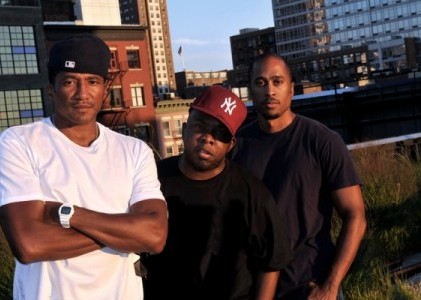Beats, Rhymes, and Film
As a lifelong hip-hop fan, watching the hugely influential hip-hop film Wild Style for the first time in 2011 is a stereophonic experience. On the one hand, its plot (such as it is), its characters, and its mood are new to me; on the other, nearly every line of the film's dialogue is familiar, having been sampled on countless rap songs in the past 30 years. I knew the movie before I'd ever seen a single frame of it—an appropriate sensation, as it turns out, for the genre to which it belongs. The pleasures of the hip-hop film have much to do with familiarity. Whether documentary, comedy, or gangster picture, the movies have always sampled their energy and attitude from the rough-edged, profane, and vibrant world created by the music. With the release on July 8 of Beats, Rhymes, & Life, the new documentary on the career, and the personal turmoil, of beloved 1990s group A Tribe Called Quest, the time is ripe for a reassessment of hip-hop's occasionally charmed presence onscreen.
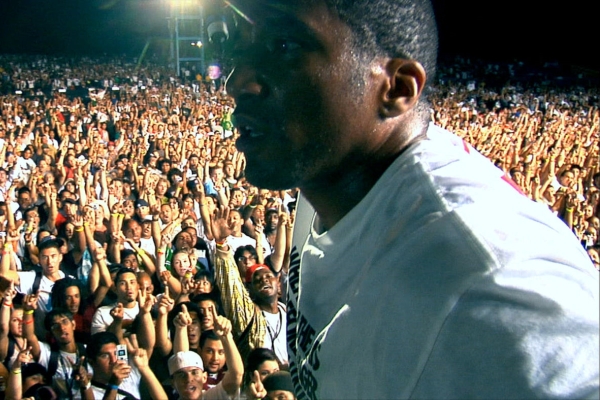
Beats, Rhymes & Life, directed by Michael Rapaport
Hip-hop films can be loosely organized into three categories: the comedic, the hagiographic, and the gritty. Hip-hop is alternately to be mocked for its excesses, celebrated for its poetic authority, or respected for its integrity to the truth of the streets. Rather than emerge slowly, hip-hop films have tended to emerge in clumps. There are the early 1980s explorations of a burgeoning art form, the early 1990s burlesques of a booming industry, and the attempts of the mid-2000s to romanticize the emergence of a global force.
The first pair of hip-hop films came in the early 1980s, with both Charlie Ahearn's Wild Style (1983) and Henry Chalfant and Tony Silver's documentary Style Wars (1984) visiting the South Bronx, where MCs, breakdancers, DJs, and above all, graffiti artists were forming the four elements of hip-hop. Both Wild Style and Style Wars celebrate the outlaw culture of graf writers, skulking in train yards in the dark of night, even as they document that same culture in the act of being swallowed whole by downtown hipsterati. Wild Style is a curious amalgam of mismatched parts, its indelible live performances by the likes of the Cold Crush Brothers and Double Trouble offset, in large part, by the mediocre script, indifferent acting, and lackluster direction. As a document of hip-hop's early years, Wild Style has a significance on the order of the Old Testament; as a film, it's more on the level of the collected works of L. Ron Hubbard.
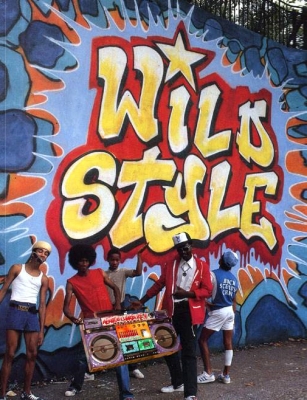
Wild Style, directed by Charlie Ahearn
Style Wars, initially broadcast on PBS, is more assured, even as its connection to hip-hop is slightly more tenuous. It is amusing, to say the least, to see a film about the real-life Bronx teenagers—as much white and Hispanic as African American—who created graffiti scored to a whitebread instrumental soundtrack. But Style Wars' buzzing energy stems from its romanticism, its devotion to the artistry of teenage miscreants, and its unflagging energy in pursuing the most magnificent examples of New York graffiti, from the 4 trains to the tunnels hundreds of feet below the street.
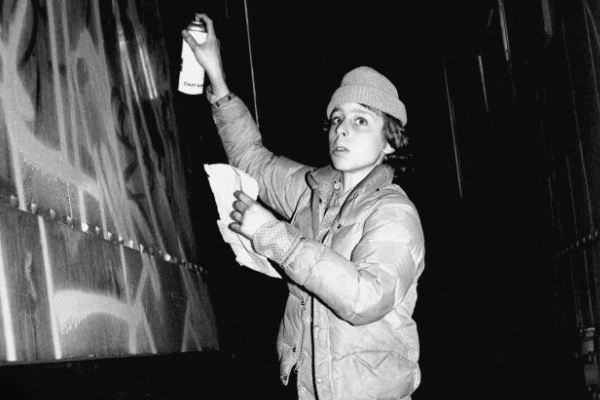
Style Wars, directed by Henry Chalfant and Tony Silver
It fell to two nearly identical gangsta-rap parodies to mock the excesses of early-'90s hip-hop, and the exaggerated thuggishness of West Coast rap in particular. Both CB4 (1993) and Fear of a Black Hat (1993) conjoin the mockumentary tone of This Is Spinal Tap to hip-hop culture, substituting N.W.A.'s Straight Outta Compton as its new foundational document. Chris Rock stars in CB4 as a polite middle-class boy (straight outta Locash, California) turned gangsta-rap superstar. CB4 warmly embraces hip-hop even as it gleefully jeers its pretensions to realism. The comic prodigality of the era comes in for its share of ribbing, from Afrocentric garb to Public Enemy-style black nationalism (CB4 member Dead Mike has a message song called "I'm Black, Y'all"). In the end, the members of CB4 eschew the gangsta trappings and embrace hip-hop purity, performing the Sugarhill Gang's "Rapper's Delight" for an audience of enthusiastic fans. Fear of a Black Hat is startlingly similar to CB4, but without the likes of Rock and Chris Elliott, feels blander, and even more indebted to Spinal Tap. There are the same Vanilla Ice jokes, the slew of Ice Cube wannabes (Ice Coffee, Ice Berg, Ice Cup, and the like), the familiar-sounding album titles (Fear of a Black Hat, aping Public Enemy's Fear of a Black Planet), and the rotating array of perilously short-lived managers, much like Spinal Tap's drummers. Where N.W.A. had declared "Fuck tha Police," the film's N.W.H. (Niggaz With Hats) set their sights a bit lower with their hit single "Fuck tha Security Guards."
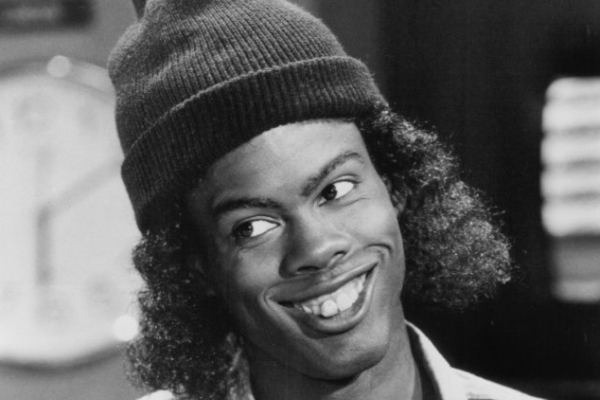
Chris Rock in CB4, directed by Tamra Davis
With hip-hop no longer a fad or a regional phenomenon but a global culture, traces of romanticism began to seep into cinematic portrayals of the MC. Like the superhero films of the era, these were origin stories, preferring the rise to the reign, emergence to maturity. Freed of the self-mockery of CB4 and Fear of a Black Hat, films about Tupac Shakur, the Notorious B.I.G., Eminem, and 50 Cent borrowed the conventions of other genres like the gangster film and the coming-of-age story, while grafting on a fully formed hip-hop mythos of freedom and peril familiar to fans of the music. In so doing, the hip-hop film brushed perilously close to unwitting parody: Was it CB4's Stab Master Arson who shouted out to Tony Danza for helping him keep strong during a prison stint, or was it Tupac? (It was, hilariously enough, Mr. Shakur.)
The semi-autobiographical 8 Mile (2002), directed by Curtis Hanson, is easily the best of the group, its grubby tribute to the ruined glamour of Detroit the backbone of its coming-of-age story. In his debut performance, Eminem plays a cleaned-up version of himself, trailer trash turned unlikely hip-hop hero. Rather than ignoring the awkward elements of its story, 8 Mile confronts them head-on, thrusting Eminem's Rabbit into a mostly African American world of battle rappers, and wondering just what he might be doing there. But Rabbit takes on the mantle his onstage opponents seek to thrust on him: "I am white, I am a bum, I do live in a trailer with my mom."
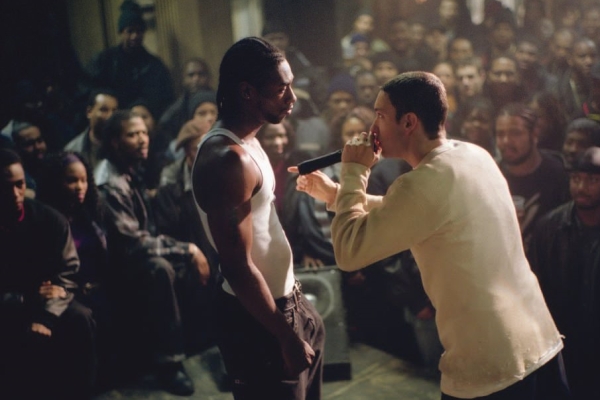
Eminem in 8 Mile, directed by Curtis Hanson
8 Mile is a sports film in the guise of a music film, a tale of the reluctant warrior summoning the strength to win a final battle. But Hanson and Eminem are honest enough to acknowledge that not every Rabbit becomes a superstar; after winning the climactic battle, Rabbit gets on the bus and heads back to the night shift at the plant where he works.
Like 8 Mile, Hustle & Flow (2005) is a story of transformation through music. Djay (Terrence Howard), a low-level drug dealer and pimp with a violent streak, finds a kind of redemption in hip-hop, "making music with simple tools, by any means necessary," as his white collaborator (DJ Qualls) describes their work. Craig Brewer's film is also devoted to the process, not the results, preferring the thrill of artists finding their voices to the perks of stardom. Hip-hop is a dream of the disenfranchised, whereby they transmute their pain and their frustration into song. "It's Hard Out Here for a Pimp" is Djay's mantra long before it becomes an Oscar-winning song. Hustle is never entirely sure how it wants us to feel about its protagonist, but the scene of Djay and his associates taking some lines scribbled on a notepad, a wobbly piano loop, and some cymbal clatter and forming the song "Whoop That Trick" is one of the most thrilling in hip-hop cinema.
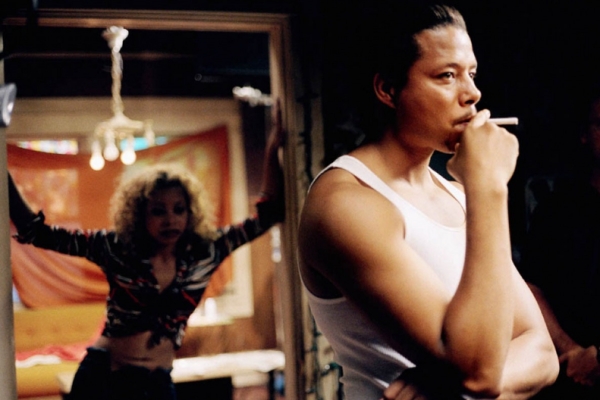
Terrence Howard in Hustle & Flow, directed by Craig Brewer
If the combination of a critically lauded director and a rap star worked once, why not twice? Jim Sheridan and 50 Cent paired up for the 8 Mile-biting Get Rich or Die Tryin' (2005), which strives for the earlier film's poetry of realness and winds up with a hollow hagiography of the hip-hop hustler. "I'm a gangsta," 50's street tough Marcus tells his newfound love (Joy Bryant). "I'm a rapper. I'm a gangsta rapper." But the film, all hustle and no flow, devotes too much of its energy to GoodFellas-lite street tussles and not enough to the artistic struggles that energized 8 Mile. Sheridan has an eye for the telling image—Fiddy carving lyrics with a razor onto the wall of his jail cell, or intercutting the scene of his post-shooting surgery with flashbacks to his birth—but the elemental confusion of tone, and 50 Cent's limitations as a performer, make this story of the birth of an artist a surprisingly empty experience, less about the rap than the gangstas.
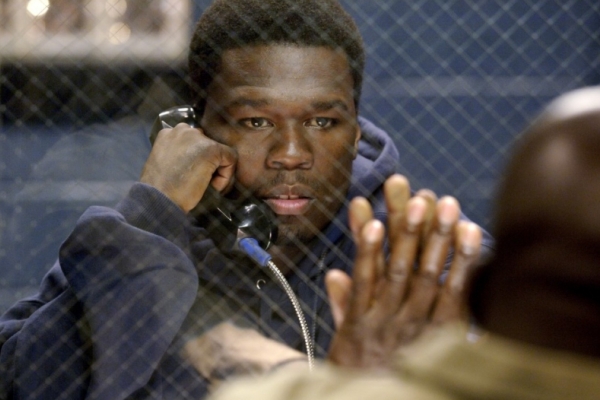
50 Cent in Get Rich or Die Tryin', directed by Jim Sheridan
Even documentaries gave in to the desire to worship their subjects. The Oscar-nominated Tupac: Resurrection (2003) uses the beguilingly strange device of having the deceased Shakur narrate his own life story. The effect is eerie, as if Shakur were speaking from the grave (and perhaps playing off the "Tupac lives" rumors that still scurry around the darker corners of the Internet). Director Lauren Lazin transforms the biography into a hall of mirrors, with Shakur lashing out and then commenting on his own intemperate behavior, all within the same frame. But the broad outline of Lazin's story—the son of a Black Panther turns his art into a new kind of political activism—is not entirely borne out by the facts.
Treating his "Thug Life" manifesto as if it were a serious political document only makes Tupac sound ridiculous, rather than the tightly massed bundle of contradictions that he actually was. The film eventually breaks down into a detailed description of Shakur's run-ins with the law and fellow rappers, and his increasingly convoluted explanations of his own impetuousness. "I felt I can't change," he notes near the end of the film, and the story of a teenage ballet dancer and Digital Underground hype-man becoming his own self-created gangsta archetype is, more than Get Rich's mock-operatic aria, a hip-hop tragedy, if one largely unexplored by Tupac. (Nick Broomfield's Biggie and Tupac heads yet further down the wormhole of conspiracy-mongering, regarding both deaths as the product of a money squabble turned murderous.)
Both Resurrection and Notorious (2009), the biopic devoted to the life of the Notorious B.I.G., revolve around the mid-'90s East Coast/West Coast rivalry that quickly grew heated, and may have played a part in the violent deaths of both rappers. Notorious is a jukebox musical with a yen for GoodFellas (apparently the most popular film for aspiring hip-hop filmmakers), syncing its medley of Biggie hits to the ups and downs of its thug-life plotline: "Ten Crack Commandments" for a young Chris Wallace hitting the streets as a drug dealer, and so forth. 8 Mile and Notorious share a romantic notion of the rapper as outlaw hero, turning painful experience into poetry. With its initial gleeful lawlessness crimped by a steadily encroaching paranoia, Notorious echoes GoodFellas in all but name, with the life of a Cosa Nostra middleman replaced by that of a famously successful Brooklyn-bred rapper. "In the beginning, God gave me a clean slate," Jamal Woolard's B.I.G. tells us at the outset, but the outline of the bullet that will end his life is already reflected in his sunglasses.
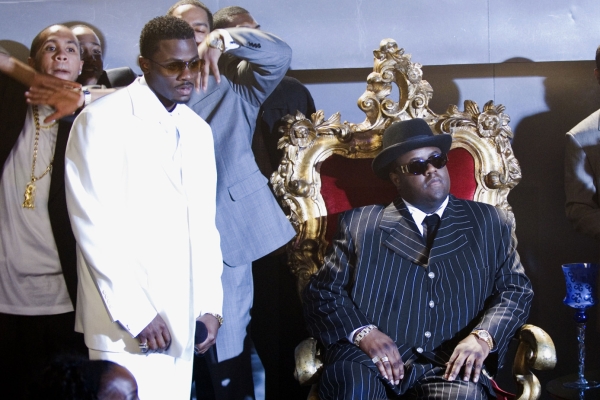
Jamal Woolard in Notorious, directed by George Tillman Jr.
Michael Rapaport's cinematic mash note-cum-documentary on the groundbreaking 1990s hip-hop group A Tribe Called Quest, Beats, Rhymes, & Life, occupies territory only distantly linked to the paranoid, blood-spattered land of Tupac: Resurrection, Get Rich, and Notorious. Indeed, the members of A Tribe Called Quest come in for some good-natured ribbing from their peers for their pan-African hippie aesthetic. Tribe's sartorial choices in those early years, which tended toward brightly colored African patterns, were "some real questionable-type shit," notes the Roots' Black Thought with a smile. Beats is a warmhearted tribute to an earlier, more diverse era in hip-hop, when the likes of Tribe, De La Soul, and the Jungle Brothers could make sunny, experimental, vibrant music.
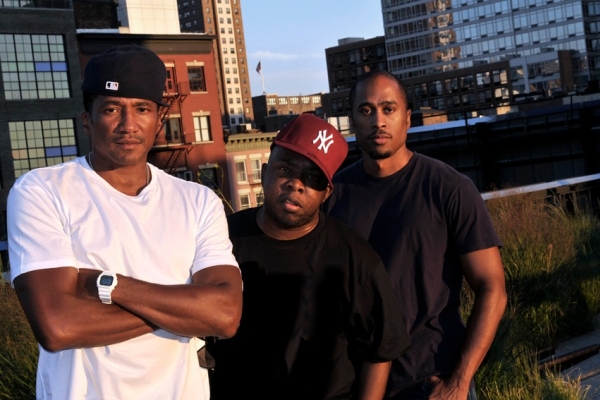
Beats, Rhymes & Life
"This dude is Charlie Parker," fellow MC Common says admiringly of Tribe's Q-Tip, but much of Beats is devoted to the tension between him and his bandmate Phife Dawg, which leads to the band's breakup. In its formation-success-discord template, Beats could be an episode of VH1's Behind the Music, and yet the brotherly squabbling between Q-Tip and Phife Dawg, by dint of its murkiness, feels real in a way other groups' strife rarely does. Phife is not merely the second banana in a group with only room for one star, but also a deeply private man going through a medical crisis alone, and protective of his dignity. When the band reunites around Phife's hospital bed after his kidney transplant, astute viewers may be reminded of the climactic scene of Fear of a Black Hat, in which a squabbling group comes together again when one of them is in the hospital, and see life imitating art. But Q-Tip, the solitary genius of the group, is nowhere to be seen. Life retains a messiness that fiction rarely does, and Beats never attempts to tie a neat bow around its story.
Hip-hop nostalgists of all ages will have a field day with Beats. There's Mike D! There's Busta Rhymes! DJ Red Alert! De La Soul! After the initial shock of recognition, and the processing of the ravages of age on once-youthful cultural heroes, Beats is a reminder that when compared to its older brother, rock & roll, hip-hop's presence onscreen—as explicit subject matter, not musical backdrop—has been surprisingly thin. Hip-hop often found a more conducive home in the music video, which made itself open to the sampling and repurposing that had given birth to hip-hop. But it was the movies that gave hip-hop the opportunity to explore the mythology that the music (and music videos) had done so much to create. ![]()
LATEST ARTICLES
-20140814-173707-thumb3.jpg)
Fighting Words
by Imogen Sara Smith
posted August 12, 2014

Fighting Words, Part 2
by Imogen Sara Smith
posted August 20, 2014

On the Margins: The Fil…
by Andrew Chan
posted August 12, 2014

Robin Williams: A Sense…
by David Schwartz
posted August 12, 2014
 Beats, Rhymes, and Film
Beats, Rhymes, and Film
THE AUTHOR
Saul Austerlitz is at work on a book on the history of American film comedy.
More articles by Saul Austerlitz
